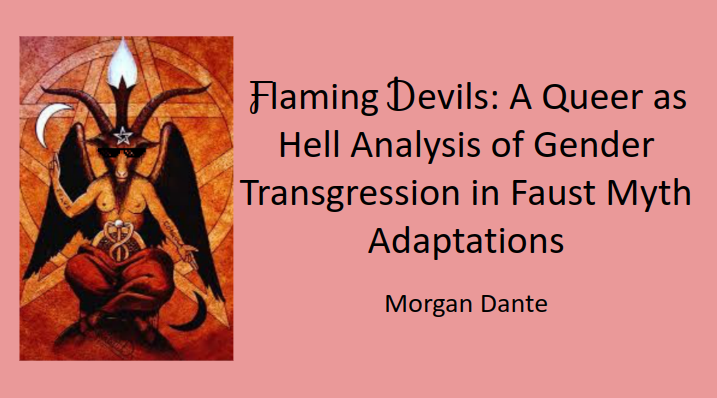Flaming Devils: A Queer as Hell Analysis of Gender Transgression in Faust Myth Adaptations12/10/2022 Note: Apologies for any awkward formatting or typos. For full context, this was my English lit senior thesis back in 2016. Many people have asked to read it, but I've never tried to get it published anywhere. I'm proud of it, but it's also a very niche analysis. I've gone through and added sections and tried to space out some of the longer paragraphs. I also went through and bolded some important points; the formatting erased the many, many italics, but I hope it isn't too disruptive.
Also, the translation for Goethe's Faust I'm using is by David Luke, and as someone who can speak basic German, I recommend this version because it captures a lot of nuances and wordplay, especially in Mephistopheles' verses, that I feel other translations miss. Anyway, to all Faust and Faustopheles lovers: Enjoy! *** Introduction The story of Faust, in its various incarnations, appears to be a male-oriented, heteronormative myth with an initial glance. On a surface level, Faust’s journey involves a man who indulges himself with magic, spectacles, and women. Much of the plot hinges on Faust’s sexual attraction to women, as well as the fixation on Helen of Troy in works such as Christopher Marlowe’s Doctor Faustus and Johann Wolfgang von Goethe’s Faust, Part Two. Accompanying characters tend to be overwhelmingly coded as male regardless of humanity or lack thereof, from Mephistopheles to Wagner to Satan to the unfallen angels to God Himself. With this, the figure of Dr. Faust and his struggle with good and evil seem to encompass the image of a heterosexual everyman. However, though the Faust myth appears male-centric and heteronormative on a surface level, variations of the Faust myth, such as Doctor Faustus, Faust, Part One, Faust, Part Two, and The Devil’s Own Work complicate the characters’ sexualities and gender identities. The queer subtext between characters such as Faust and Mephistopheles and Chantal and Eudoxie, as well as Faust’s thirst for knowledge paralleling the plights of Eve and womankind, ultimately reveal the perceived dangers of social transgression in terms of queer sexual desire and women’s rights. This paper will examine multiple works from the sixteenth century to contemporary media through a queer feminist lens. It will encompass the examination of letters concerning the historical figure of Dr. John Faustus, Marlowe’s tragedy Doctor Faustus, both parts of Goethe’s tragedy Faust, Roman Polanski’s horror film Rosemary’s Baby, Alan Judd’s novella The Devil’s Own Work, and Emma Tennant’s novel Faustine. When discussing the transgender nature of Faust, particularly Dr. Faustus, transgender is a combination of two words, “transgressive” and “gender,” and a transgressive identity involves breaking established social norms, such as a strict gender binary. Queer is an umbrella word which encapsulates marginalized gender and sexual identities that are neither heterosexual or cisgender (someone’s current gender identity matches their assigned-at-birth gender). When discussing bisexual characters, such as Goethe’s Mephistopheles, bisexual refers to a sexual orientation where an individual experience attraction toward two or more genders. Before the chapbook The History of the Damnable Life and Deserved Death of Doctor John Faustus circulated, a German man named John Faustus who wandered and performed alchemy and magic tricks. He allegedly sold his soul to the Devil, which formed the legend of Faust. A series of letters from various individuals, many religious leaders opposed to Faustus’ alleged actions, which range from sex with male school students to cannibalism to raising the dead; more than one of the letter writers accuse Dr. Faustus of sodomy. According to the Oxford English Dictionary, sodomy encompasses “any form of sexual intercourse considered to be unnatural. Now chiefly: anal intercourse.” Sodomy, as defined here, is often associated with homosexuality and male-on-male anal intercourse, though heterosexual sex acts can align with this description, and not all gay men engage in identical sex acts. The first letter present in Lorna Fitzsimmons’ Lives of Faust, correspondence between Johannes Tritheim and Johannes Virdung, alleges that when Faust became a schoolmaster “he began to indulge in the most dastardly kind of lewdness with the boys and when this was suddenly discovered, he avoided by flight the punishment that awaited him” (23). Meanwhile, Nuremberg’s entry records report “Safe conduct to Doctor Faust, the great sodomite and necromancer, at Fürth refused” (25). Furthermore, perhaps speaking of the same instance Tritheim writes of, Christlich Bedencken corresponds with Augustin Lercheimer and states of Faust, “For a time he was a schoolmaster in Kreuznach under Franz von Sickingen: he had to flee from there because he was guilty of sodomy” (38). A common thread in these documents is Faust’s ostracization through society, either through barred entry or fleeing once his sexual proclivities are unearthed. The tale intends to be didactic, meaning it lends moral instructions, albeit in a brusque manner. To sin not only against Biblical statutes, but social ones as well, led to an association with devilry. Fitzsimmons states, “There was no such thing as a trivial decision: you must choose the devil or choose Christ. Loaf at work, and you are acting like a follower of the devil. Rebel against your superior...and you have declared yourself a loyalist of Satan” (45).
0 Comments
|



 RSS Feed
RSS Feed